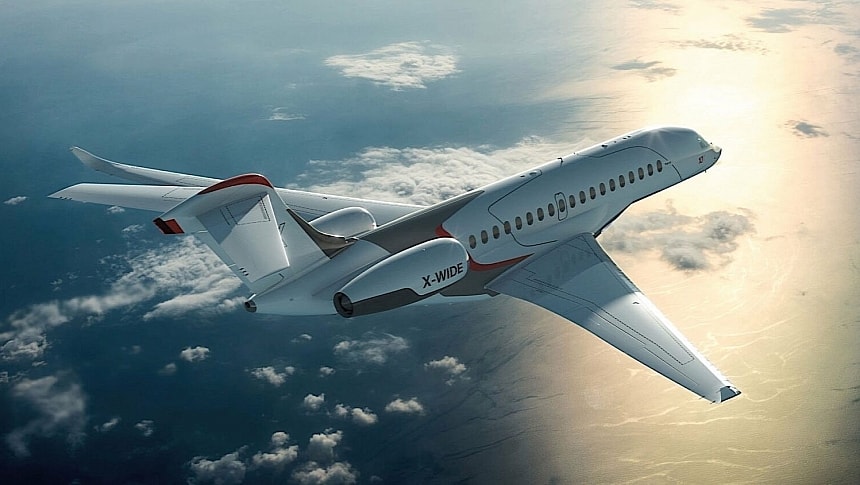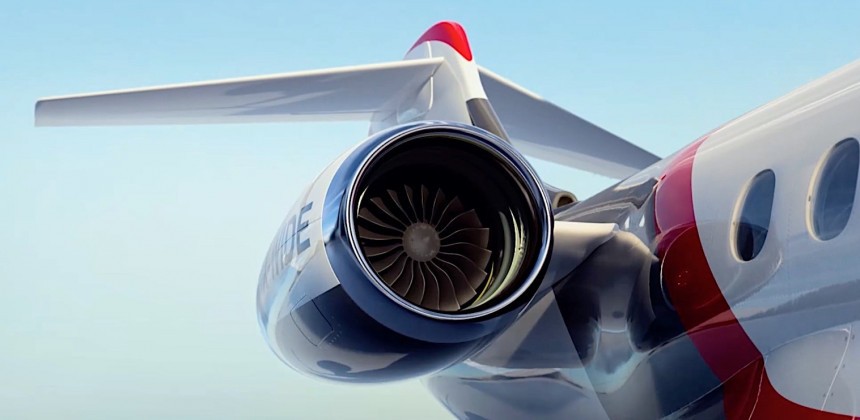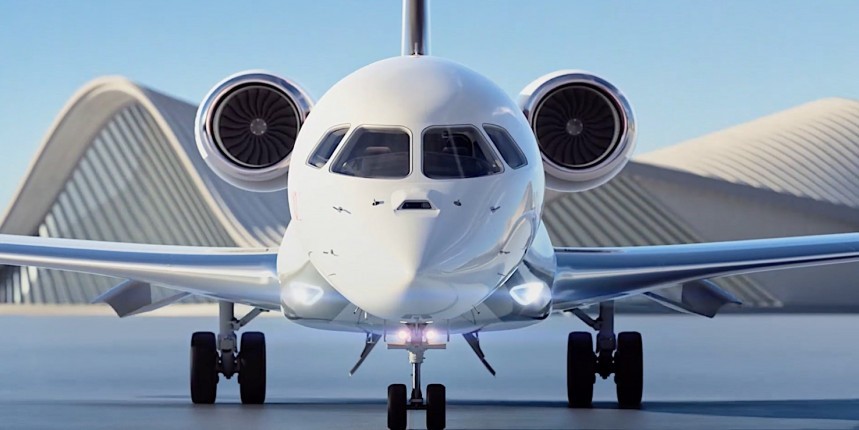They call it the Pearl 10X, and it's a business engine so exciting it might just as well have been fitted on a fighter jet. Produced by Rolls-Royce, the Pearl 10X just entered the final stretch to become fully operational.
The name Pearl 10X was made public for the first time back in 2021 as the most powerful business aviation engine Rolls-Royce had ever made. How powerful? Think 18,000 lbs of thrust, which should be more than enough to push airplanes to speeds close to that of sound.
The engine will first be featured on a business jet being developed by French airplane company Dassault. The plane is fittingly called Falcon 10X, and it will be the first Dassault product to use a Rolls-Royce power unit.
After announcing it three years ago the engine maker has been hard at work testing the engine on the ground. To date, over 2,300 test hours have been performed on it, including a full run of the complete unit, ultra-slim nacelle included.
It was in 2023 that Rolls-Royce announced the first test flight of the engine would take place by the end of that year, but for one reason or another that did not happen. It did now, four months into 2024.
Rolls-Royce said this week it has "kicked off the flight test campaign for its latest aero engine for the business aviation market," with the first test flight taking place (as will the ones to follow) in Tucson, Arizona.
The engine was not flown on the Dassault aircraft it was born to power (the plane itself won't be ready to take to the sky before 2025), but on a Boeing 747 Rolls-Royce is using as a testbed.
This first flight, whose duration and other specifics (other that it surpassed its target thrust levels) were not made public, will be followed by many others in the coming months as Rolls is racing to match the launch date for the Dassault airplane. Testing procedures will target everything from engine performance to the nacelle's anti-icing system at various altitudes and speeds.
The Pearl 10X engine uses something called the Advance2 engine core. The technology is described as "the most efficient core available across the business aviation sector," and aside from providing the aforementioned thrust levels, it also comes with a five percent higher efficiency than the most recent generation of Rolls-Royce engines.
On top of that, it is fully compatible with sustainable aviation fuel (SAF) and can run exclusively on that, meaning it will release a lot less harmful gases. That sounds great and all, but how does it translate into aircraft performance?
When installed on the Falcon 10X, the engine (or the engines, as there will be two of them on this aircraft) will be able to push the Dassault to a top speed of Mach 0.925. Translated into more humane numbers, that would be 710 mph (1,142 kph).
The plane's tanks will be able to hold enough fuel to keep the engines running for as much as 8,600 miles (13,900 km) – but that only if the top speed does not exceed Mach .85 (652 mph/1,049 kph). The maximum altitude of the aircraft is said to be 51,000 feet (15,545 meters).
Dassault and Rolls-Royce expect the plane to easily cover the distance between New York and Shanghai (over 7,300 miles/11,700 km) in a single flight, without refueling. The time it will take the Falcon 10X to move from one of these cities to the other should be about 11 hours.
The plane itself will be one of the most alluring propositions in its segment and a serious competitor for the aircraft made by the other two big players in this market, Bombardier and Gulfstream.
The French machine will be capable of carrying up to eight passengers and an additional four crew. The plane promises to offer the biggest cabin on the market, letting light in through no less than 38 windows.
The cabin is typically divided into four zones, but the customization options that are on the table and the modularity of the layout allows for virtually endless choices.
While some people, for instance, will go for a typical aircraft layout, others could easily bring home with them in the sky and spec anything from a dining area and entertainment zone to a master suite with a private stand-up shower.
The passengers' communication needs are handled through high-speed connectivity, including Ka-band networking, while the pilots will use advanced systems such as the Falcon Digital Flight Control Technology and the FalconEye Combined Vision System.
All of the above things considered, the Dassault Falcon 10X will not be a very cheap plane to own, but not over the top either. Although the exact price of the plane is not yet known, estimates place it at around $75 million, which is roughly what the competition is asking for their products from this class.
The engine will first be featured on a business jet being developed by French airplane company Dassault. The plane is fittingly called Falcon 10X, and it will be the first Dassault product to use a Rolls-Royce power unit.
After announcing it three years ago the engine maker has been hard at work testing the engine on the ground. To date, over 2,300 test hours have been performed on it, including a full run of the complete unit, ultra-slim nacelle included.
It was in 2023 that Rolls-Royce announced the first test flight of the engine would take place by the end of that year, but for one reason or another that did not happen. It did now, four months into 2024.
Rolls-Royce said this week it has "kicked off the flight test campaign for its latest aero engine for the business aviation market," with the first test flight taking place (as will the ones to follow) in Tucson, Arizona.
The engine was not flown on the Dassault aircraft it was born to power (the plane itself won't be ready to take to the sky before 2025), but on a Boeing 747 Rolls-Royce is using as a testbed.
The Pearl 10X engine uses something called the Advance2 engine core. The technology is described as "the most efficient core available across the business aviation sector," and aside from providing the aforementioned thrust levels, it also comes with a five percent higher efficiency than the most recent generation of Rolls-Royce engines.
On top of that, it is fully compatible with sustainable aviation fuel (SAF) and can run exclusively on that, meaning it will release a lot less harmful gases. That sounds great and all, but how does it translate into aircraft performance?
When installed on the Falcon 10X, the engine (or the engines, as there will be two of them on this aircraft) will be able to push the Dassault to a top speed of Mach 0.925. Translated into more humane numbers, that would be 710 mph (1,142 kph).
The plane's tanks will be able to hold enough fuel to keep the engines running for as much as 8,600 miles (13,900 km) – but that only if the top speed does not exceed Mach .85 (652 mph/1,049 kph). The maximum altitude of the aircraft is said to be 51,000 feet (15,545 meters).
Dassault and Rolls-Royce expect the plane to easily cover the distance between New York and Shanghai (over 7,300 miles/11,700 km) in a single flight, without refueling. The time it will take the Falcon 10X to move from one of these cities to the other should be about 11 hours.
The French machine will be capable of carrying up to eight passengers and an additional four crew. The plane promises to offer the biggest cabin on the market, letting light in through no less than 38 windows.
The cabin is typically divided into four zones, but the customization options that are on the table and the modularity of the layout allows for virtually endless choices.
While some people, for instance, will go for a typical aircraft layout, others could easily bring home with them in the sky and spec anything from a dining area and entertainment zone to a master suite with a private stand-up shower.
The passengers' communication needs are handled through high-speed connectivity, including Ka-band networking, while the pilots will use advanced systems such as the Falcon Digital Flight Control Technology and the FalconEye Combined Vision System.
All of the above things considered, the Dassault Falcon 10X will not be a very cheap plane to own, but not over the top either. Although the exact price of the plane is not yet known, estimates place it at around $75 million, which is roughly what the competition is asking for their products from this class.






















